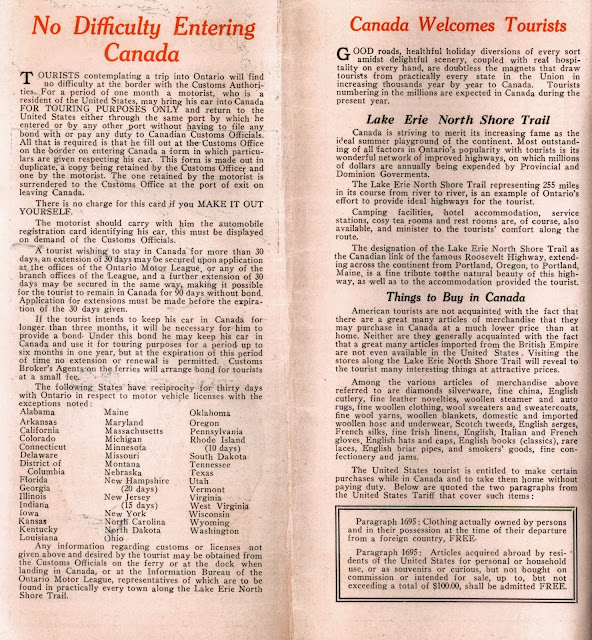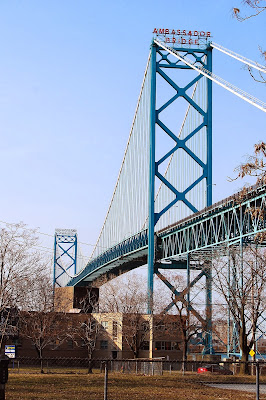Lake Erie North Shore Trail, 1927
In my last post, I mentioned our antique store visit netted us two vintage tour maps. The first was from New Jersey, and the second one is posted above...a nice leisurely driving tour guide to Southern Ontario via the Roosevelt Highway, Provincial Highway 3. This publication grabbed my eye for the same reason the New Jersey one did...the bright colors and signature 1920's artwork. Although difficult to read, this publication is labeled the "1927 Edition" and has been stamped with "All Paved" on the very top in two places to alert interested motorists that the road to rest and relaxation would be a smooth one. Check out the depiction of the open touring car on the rolling lakefront, Niagara Falls, and young ladies in sporting attire enjoying a few rounds of golf! This is neat stuff!
Let's take a little peek inside this pamphlet.
Page one assures American travelers that there's little difficulty entering Canada, why its practically another state, right? As long as you read the bold type that says you can bring your car into Canada FOR TOURING PURPOSES ONLY and then return it it to the United States within 30 days. Heck, they say Canada even welcomes tourists, which they still do...its just a little harder to get across the border in 2013 than it was in 1927.
Some of the suggestions for items to buy while on tour in Canada include Scotch tweeds, smoker's goods, and auto rugs. As long as you didn't spend more than $100.00 on items for your personal use, you were free from paying duty on them upon your arrival back in the states. Has all this talk about fine imports and tariffs piqued your interest? Well, read on to learn about all the amenities that Ontario has to offer: 60% paved roads, unspoiled wilderness and clean hotel rooms...
The blurb about the Gasoline, oil and service stations is noteworthy for their mention of 'Imperial gallons' of gasoline in reference to the US "Wine Gallon". Metrication of fuel sales in Canada officially happened in 1981, and gasoline is sold by the liter today. Wine gallon? That's a lot of wine...especially during prohibition. That was another good reason for Americans to visit Ontario back then, eh? I'd imagine a gallon jug of wine would last quite a while during your tour of Lake Erie's North Shore Trail. Let's take a look at the tour map...
The suggested route follows the shoreline of Lake Erie from Detroit, Michigan to Buffalo, New York, using the Theodore Roosevelt International Highway. Thanks to the development of that highway system, it was now possible to drive a loop along Lake Erie by automobile. The Michigan portion of the roadway was completed in 1926 and extended from the Detroit River all the way up to the Upper Peninsula, while the Canadian side, Provincial Highway 3, would take passengers from Windsor to the brand new Peace Bridge near Niagara Falls. This bridge connected Buffalo with Fort Erie, Ontario. Detroit's Ambassador Bridge does not appear in this publication since it was under construction in 1927*.
Ontario Highway 3 still exists as three noncontinuous segments, and the Roosevelt highway was renamed in 1935 to fall in line with the US's numbered highway naming conventions. A few more pages of this map shows summaries of the Ontario towns along the route and noteworthy attractions in each. It includes hotel names, restaurant locations, and even a few pictures of businesses travelers could frequent. Its a nice find and I'm proud to own a window into the motoring world of 1927.
*Bonus!
Stuffed into the back of the above brochure was this vintage postcard from the Ambassador Bridge spanning the Detroit River. What's unique is that its missing any image or sketch of the bridge. There's no date listed, but I would assume this was either a promotional item from before the launch or very soon after.
 |
| Photo Credit: Detroit International Bridge Company |
The Ambassador Bridge opened to traffic on November 11, 1929 to connect Detroit and Windsor for a toll. Just a few days prior, the stock market collapse of "Black Thursday" rained on everyone's parade...but an eager motoring public and dignitaries such as Prince George still managed to travel the route.
 |
| Cars lining up for a first pass on the Ambassador during its inaugural year. |
Looking back on this set of papers from the late 1920's, I can't help but think of the giant appetite for new ideas. New structures, new technologies, new capabilities. Before the collapse of the stock market, massive projects such as the construction of the Ambassador were launched. Skyscrapers such as the Chrysler Building and Empire State Building began to dot the landscape of New York City. Locomotives were still fed with coal and water, but began to evolve into streamlined hulks of rolling sculpture and quicken their pace through each city. And routes such as the Roosevelt, Lincoln, and Grand Army of the Republic Highways, branched out to connect towns with villages with cities. Thanks to better transportation and technology, Americans improved their standing and quality of life for a short while, before the whole cookie crumbled in '29 and we spent the next nearly 20 years playing catch-up following WWII. Relics of the roaring twenties make me stand back and marvel at the accomplishments of our ancestors. They did so much in a short amount of time, while today we spend our days on a computer...reading blogs about cars.
I can't think of a piece of music more suited to this era and these pieces of history than George Gershwin's Prelude Number 2, performed by Gershwin himself. I hope you'll indulge me...I'm in a strange mood. But I hope you'll find that it suits this post. Play us out, George.
That's all for this week's ramblings, unless I go back to the antique store and buy some more vintage maps. Thanks for passing though, and happy motoring.
-D









Comments
Post a Comment
Thank you for your feedback on Throwin' Wrenches.